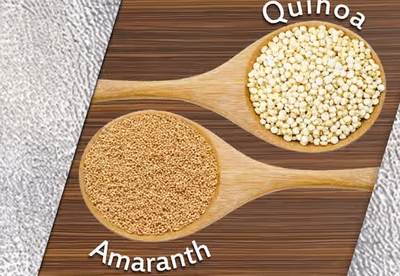
Rajgira vs Quinoa: Rajgira and quinoa are both pseudocereals. They are gluten-free, which is best for people with celiac disease. However, there is a difference in the nutritional value of both.

Rajgira and Quinoa Comparison: Health-conscious people are looking for superfoods these days. This is the reason why grains like Rajgira i.e., Amaranth and Quinoa are popular in the market. Both are rich in protein, but the question is which one is better for health? Let us know which one is best for your health according to calories, protein, fat, fiber, nutrients like calcium, magnesium and price.
Manas Samarth, a certified nutritionist, diabetes and health educator from Lincoln University College, Malaysia, said that both Rajgira and quinoa are good. Both are pseudocereals. This means that they are not real grains, but are like seeds. They are gluten-free, which is best for people with celiac disease. However, there is a difference in the nutritional value of both. According to USDA data, let us know what you get from 100 grams of cooked Rajgira and quinoa?
Calories: Who's ahead in weight control?
This is very important for those who count calories. 100 grams of cooked Rajgira has only 102 calories, while quinoa has 120 calories. This means that Rajgira is low in calories, which is better in a weight loss diet. According to Manas Samarth, if you are suffering from diabetes or obesity, then choose Rajgira. It causes less spike in blood sugar. Quinoa gives a little more energy, but it is important to avoid overeating.
Protein: What's Best for Building Muscle?
Protein is essential for bodybuilding and daily recovery. 100 grams of cooked Rajgira contains 3.8 grams of protein, while quinoa contains 4.4 grams of protein. Quinoa seems to be a little ahead, but Rajgira's protein is of better quality. It contains more amino acids like lysine. On the other hand, the protein of quinoa is complete, but Rajgira is better for children and the elderly, because it is easily digested. If you go to the gym, you can mix both and use them.
Fats: What are the best healthy fats?
Rajgira contains 1.6 grams of healthy fat, while quinoa contains 1.9 grams. Both are rich in unsaturated fats, which are good for the heart. However, Rajgira contains more omega-3, which reduces inflammation. Manas Samarth says that there is not much difference in fat levels, but Rajgira helps in controlling cholesterol.
Fiber: What provides relief from digestion and constipation?
Fiber keeps the intestines clean. Rajgira has 2.1 grams of fiber, while quinoa has 2.8 grams of fiber. Here quinoa gets more marks because it relieves constipation and also reduces the risk of colon cancer. However, Rajgira is also good, especially for diabetes, because its glycemic index is low (GI 55 vs quinoa's 53).
Calcium: Which is the stronger companion for bones?
Calcium is very important for bone health. Rajgira contains 47mg of calcium, but some studies have reported up to 159mg. Quinoa contains only 17mg of calcium. Rajgira is best for strengthening bones. It is a good alternative to milk. Quinoa contains less calcium, due to which supplements may have to be taken.
What is better for magnesium?
Magnesium relaxes muscles and controls blood pressure. Rajgira contains 65mg of magnesium while quinoa contains 64mg. Both are good, but the combo of Rajgira with iron is considered better. According to experts, magnesium deficiency causes migraine, for which both Rajgira and quinoa are beneficial. However, Rajgira can be used daily because it is cheaper.
Which is better for the pocket?
In Indian markets, Rajgira (Ramdana) is available at Rs 150-250 per kg, while quinoa is available at Rs 400-600 per kg. According to experts, Rajgira is more economical and beneficial in terms of price. Rajgira can prove to be better for middle-class families.